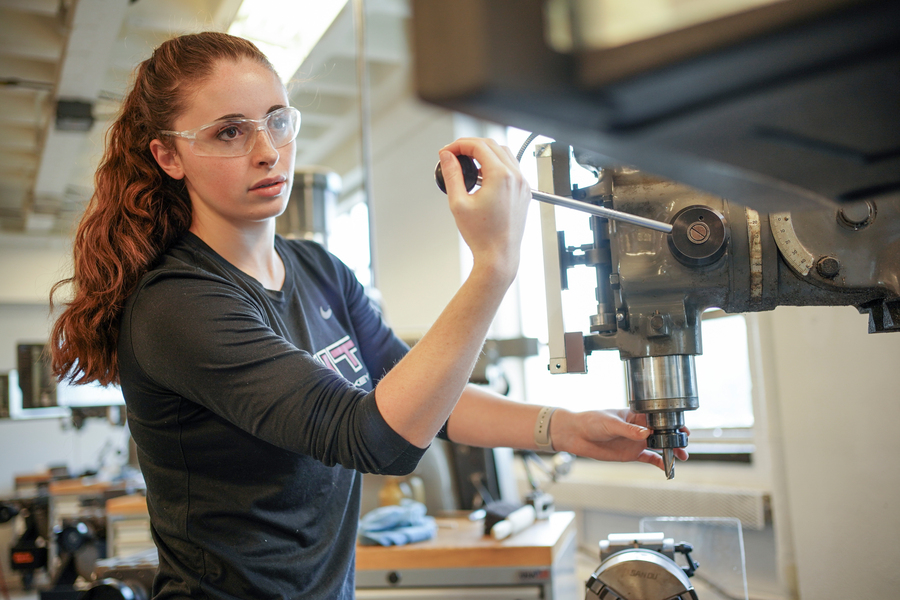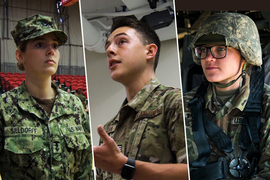Liberty Ladd has been drawn to public service and fighting injustice from a young age. At 15, as a student representative from the first congressional district of Maine, she testified to the state board of education about unfair grading policies at her school. Later, she decided to join the Air Force, with the understanding that military experience would put her on a path to ultimately making a difference on issues such as voting rights and services for U.S. veterans.
With her interest in politics — policymaking in particular — Ladd knew she wanted to study political science entering MIT. Also wanting a double major in a STEM field, she selected mechanical engineering. Ladd expects to graduate in the spring with bachelor’s and master’s degrees in political science and a bachelor’s in mechanical engineering, and has participated in the Air Force ROTC throughout her time at MIT.
Following graduation, Ladd will serve in the United States Space Force for a minimum of five years. Ladd hopes to be a positive force in shaping the new military branch to avoid inequalities faced in other older branches. She says she will stay as long as she feels she can make an impact, but she eventually wants a career in policymaking.
MIT News interviewed Ladd to learn more about her life as a student.
Q: What are your communities on campus?
A: I’m on the varsity field hockey team. Sophomore year, Covid sent us all home, so we got one extra year of eligibility. I was here for my master’s, so I figured I’d play one more year. It’s been a really fantastic support network on and off the field. Some of my closest friends are on the team.
I’m in the United States Space Force and I am in the Air Force ROTC Reserve Officer Training Corps program through MIT. Through ROTC on campus, I was the vice commander of our wing, where I was in charge of the operational and logistical operations of our training program.
I used to be on the MIT Mock Trial team, which I joined because I wanted to be a lawyer — or used to want to be a lawyer. I stayed because the team is just super fun, and we’re all really close now.
Q: What responsibilities does ROTC at MIT entail?
A: Freshman and sophomore year, you’re learning what the military is and what it does. The juniors and seniors are responsible for crafting the curriculum to prepare the underclassmen to go to field training and graduate. So, what that looks like is a lab for two hours every week, and then you have two physical training sessions a week in the mornings, and you also have Air Force or aerospace studies. Then you go to field training the summer after your sophomore year. When you come back it’s the same two-hour lab, the two hours of PT [physical fitness] a week, and then also a three-hour class.
Q: When did your journey in the military start?
A: I discovered that ROTC was a program my junior year of high school. After, I decided to serve. I didn’t know what the mechanisms were for getting there. Honestly, I didn’t even know what an officer was. But I [saw] the way that the United States treats our veterans. It’s inhumane: We’ve got mental health crises, homelessness crises with our veterans, and seeing the lack of effectiveness from policies that were set out as solutions got me thinking that I wanted to make a difference in that.
But I also knew that if I ever wanted to make policies that would help to address those crises, no one would listen to me if I had never served. So, that was my initial motivation for serving. I also knew that serving my country was something that would allow me to make a big impact at a young age.
And then I also started to learn about some of the inequities within the military, both when it comes to treatment of women and minorities, and institutionally. We’ve got a certain percentage of our members living on SNAP programs while they’re serving the military. They’re focused on trying to figure out ways to keep food on their family’s table while also putting their lives on the line for our freedom and safety. These are things that I think are untenable, but I wouldn’t be able to fix unless I was in there to kind of work within the system to make those changes.
Q: What inspires you to take on such large institutions?
A: It stems from hating to see the wrong thing being done, or people being treated poorly. Whether it be because of my political privilege of attending MIT or being a white woman, if there’s a situation where I sense that I have some sort of privilege, it feels like my responsibility to do something because I have the option of being okay when some of my peers don’t.
Q: Why pursue a second major in mechanical engineering?
A: Effective policymakers can’t afford to be ignorant about the science and technology advances that drive our society. Engineering design is an unusual but helpful background to have when making intentional, effective policy decisions.
Q: Have you encountered any situations recently in which you felt motivated to take action?
A: The big one that jumps to mind is what happened to my peers in ROTC our sophomore year. The Air Force decided to cut people in the program who were in my class, and they cut practically 50 percent. From my peers’ perspectives, they were losing opportunities to be an officer in the Air Force and some of them were losing their opportunity to go to college at all. I felt incredibly helpless.
Our regional commander happened to be in the area and was going to have lunch with some of the cadets. And I was like, “Perfect, I’m going to show him why the way that they were choosing which cadets got to stay was untenable, unfair, and hurting the needs of the Air Force.” Did that change his mind? I don’t know. But fortunately, the Air Force did change course: While not all my peers were allowed to rejoin, a large majority were. It’s the first experience that I had with how frigid the bureaucracy can be toward the people it’s supposed to be protecting. But it also made me realize that working within the system, I can make change as well.
Q: What would your 5-year-old self say to you today?
A: What’s field hockey? What’s an engineer? She would probably wonder why I wear so much pink and wear so many dresses. Five-year-old Liberty wanted to be as strong and tough and smart as the boys. I rejected everything stereotypically feminine. What society told me was that weak was feminine. I would tell her: You can be just as strong as the guys you meet and just as smart, and you can wear a pink pantsuit. I promise you; it will be okay.














